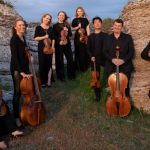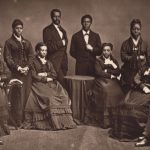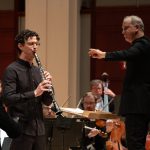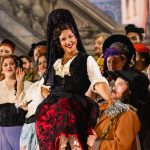May 15 & 17, 2025
Atlanta Symphony Hall, Woodruff Arts Center
Atlanta, Georgia – USA
Atlanta Symphony Orchestra; Marzena Diakun, conductor; Marc-André Hamelin, piano.
Mieczysław WEINBERG: Rhapsody on Moldovan Themes, Op. 47, No. 1 (1949)
Béla BARTÓK: Concerto No. 3 for Piano and Orchestra(1945)
Pyotr Ilyich TCHAIKOVSKY: Symphony No. 1 in G minor, Op. 13 (“Winter Daydreams”)
Mark Gresham | 10 MAY 2025
Thursday night’s concert by the Atlanta Symphony Orchestra spotlighted Polish conductor Marzena Diakun and Canadian pianist Marc-André Hamelin in a program of music by Weinberg, Bartók, and Tchaikovsky, three musical voices shaped by national identity, personal resilience, and emotional depth.
Diakun, making her ASO debut, proved a persuasive presence on the podium, guiding the ensemble through a stylistically varied program that opened with Mieczysław Weinberg’s Rhapsody on Moldovan Themes, Op. 47, No. 1. Composed in 1949, the single-movement work was an attention-grabbing intro that reminds us of what a skilled composer he was. Weinberg’s deft orchestration, reminiscent of his contemporaries (notably his friend Dmitri Shostakovich), a firm rhythmic drive, and folk influence made for an impressive intro. After a rough, less-than-coordinated first few bars, Daikun brought the ensemble together with a firm hand through its shifting moods and rustic, brooding lyricism and became an emotionally moving performance well received by the audience.
A-list pianist Marc-André Hamelin, known for his championing of lesser-known repertoire and formidable technique, brought understated brilliance to Béla Bartók’s Piano Concerto No. 3. Composed during the final months of the composer’s life in 1945, it doesn’t have the shimmer of his Music for Strings, Percussion and Celesta (1936) nor the orchestral flash of his Concerto for Orchestra (1943), instead tempering Bartók’s rhythmic angularity with moments of serene introspection.
Ever the thoughtful interpreter, Hamelin proved an ideal collaborator in the nuanced and rewarding account of the concerto. In the “Adagio religioso” second movement, Hamelin drew the audience into the work’s spiritual core, with the orchestra’s winds and strings responding in kind. The final movement, buoyant and rhythmically charged, was executed with nimble precision, earning a warm ovation from the audience.

Marc-André Hamelin (credit: Sim Cannety-Clarke)
Diakun allowed the orchestra play full out, but Hamelin’s playing never let the orchestra overwhelm his crystalline articulation and luminous, singing tone. It was the perfect blending of piano and orchestra without either having to give way to the other. Credit for that goes not only to the performers but also to Bartók’s skill as a composer and orchestrator. He understood how not to bury the piano while allowing the orchestra to be an equal partner in the performance.
The second half featured Tchaikovsky’s Symphony No. 1 in G minor, an underplayed and underappreciated early work brimming with youthful energy and poetic melancholy. Diakun drew an engaging performance from the ASO, emphasizing the long-arched phrasing and emotional contrasts that hint at the composer’s later symphonic voice. From the delicacy and grace of the “Allegro tranquillo” first movement to the warm fire of the “Adagio cantabile” second, the clever “Scherzo,” and the ebullient finale, the ASO and Daikun painted a finely wrought landscape.
Overall, the evening marked a promising local introduction for Diakun, suggesting a conductor poised for broader recognition.
As occasionally takes place with ASO concerts, there was a pre-concert recital by orchestra members at 6:45 pm, with the audience allowed to sit onstage to listen.
The pre-concert chamber music selection was Anton Arensky’s String Quartet No. 2, written for violin, viola, and two cellos—an unusual but sonically rich instrumentation. Following a brief instrumental introduction, soprano Wanda Yang Temko performed Tchaikovsky’s “Legend,” Op. 54, No. 5—the very song quoted throughout Arensky’s quartet.
The instrumental performers were Lauren Roth (violin, assistant concertmaster), Jessica Oudin (viola), and Brad Ritchie and Ramy Kim (celli). Arensky, a talented composer in his own right and a student of Russian masters Rimsky-Korsakov, Glière, and Tchaikovsky, has often been overshadowed by his teachers in recent decades. This quartet, however, stands as a poignant reminder of his artistry. Composed in memory of Tchaikovsky—who had died the year prior and whom Arensky deeply admired—the work unfolds in three movements.
The somber and lyrical first movement (“Moderato”) is an elegy to the elder composer. The second, “Variations on a Theme of Tchaikovsky,” is based on “Legend” and features seven inventive variations on that theme. The final movement (“Andante sostenuto – Allegro moderato”) takes on a more celebratory tone, incorporating allusions to Russian folk music.
The ASO performers delivered the work to perfection. Their playing was well-rehearsed, deeply committed, and heartfelt, offering a warm and reflective interpretation of this touching tribute. ■
EXTERNAL LINKS:
- Atlanta Symphony Orchestra: aso.org
- Marzena Diakun: diakun.com/en
- Marc-André Hamelin: marcandrehamelin.com

Read more by Mark Gresham.
RECENT POSTS
 Tine Thing Helseth brings fire and finesse to trumpet concertos by Arutiunian, Penderecki, and Weinberg • 24 Oct 2025
Tine Thing Helseth brings fire and finesse to trumpet concertos by Arutiunian, Penderecki, and Weinberg • 24 Oct 2025 Camerata Nordica Octet brings Scandinavian color and classical clarity to Hodgson Hall • 21 Oct 2025
Camerata Nordica Octet brings Scandinavian color and classical clarity to Hodgson Hall • 21 Oct 2025




.png)